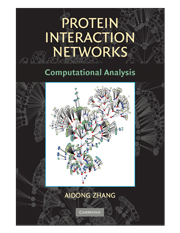Book contents
- Frontmatter
- Contents
- Preface
- 1 Introduction
- 2 Experimental Approaches to Generation of PPI Data
- 3 Computational Methods for the Prediction of PPIs
- 4 Basic Properties and Measurements of Protein Interaction Networks
- 5 Modularity Analysis of Protein Interaction Networks
- 6 Topological Analysis of Protein Interaction Networks
- 7 Distance-Based Modularity Analysis
- 8 Graph-Theoretic Approaches to Modularity Analysis
- 9 Flow-Based Analysis of Protein Interaction Networks
- 10 Statistics and Machine Learning Based Analysis of Protein Interaction Networks
- 11 Integration of GO into the Analysis of Protein Interaction Networks
- 12 Data Fusion in the Analysis of Protein Interaction Networks
- 13 Conclusion
- Bibliography
- Index
8 - Graph-Theoretic Approaches to Modularity Analysis
Published online by Cambridge University Press: 28 January 2010
- Frontmatter
- Contents
- Preface
- 1 Introduction
- 2 Experimental Approaches to Generation of PPI Data
- 3 Computational Methods for the Prediction of PPIs
- 4 Basic Properties and Measurements of Protein Interaction Networks
- 5 Modularity Analysis of Protein Interaction Networks
- 6 Topological Analysis of Protein Interaction Networks
- 7 Distance-Based Modularity Analysis
- 8 Graph-Theoretic Approaches to Modularity Analysis
- 9 Flow-Based Analysis of Protein Interaction Networks
- 10 Statistics and Machine Learning Based Analysis of Protein Interaction Networks
- 11 Integration of GO into the Analysis of Protein Interaction Networks
- 12 Data Fusion in the Analysis of Protein Interaction Networks
- 13 Conclusion
- Bibliography
- Index
Summary
INTRODUCTION
Modules (or clusters) in protein-protein interaction (PPI) networks can be identified by applying various clustering algorithms that use graph theory. Each of these methods converts the process of clustering a PPI dataset into a graph-theoretic analysis of the corresponding PPI network. Such clustering approaches take into consideration either the local topology or the global structure of the networks.
The graph-theoretic approaches to modularity analysis can be divided into two classes. One type of approaches [24, 238, 272, 286] seeks to identify dense subgraphs by maximizing the density of each subgraph on the basis of local network topology. The goal of the second group of methods [94,99,138,180,250] is to find the best partition in a graph. Based on the global structure of a network, the methods in this class minimize the cost of partitioning or separating the graph. The approaches in these classes will be discussed in the first two sections of this chapter.
PPI networks are typically large, often having more than 6,000 nodes. In a graph of such large size, classical graph-theoretic algorithms become inefficient. A graph reduction-based approach [65], which enhances the efficiency of module detection in such large and complex interaction networks, will be explored in the third section of this chapter.
FINDING DENSE SUBGRAPHS
In this section, we will discuss those graph-theoretic approaches that seek to identify the densest subgraphs within a graph; specific methods vary in the means used to assess the density of the subgraphs. Six variations on this theme will be discussed in the following subsections.
- Type
- Chapter
- Information
- Protein Interaction NetworksComputational Analysis, pp. 130 - 151Publisher: Cambridge University PressPrint publication year: 2009



